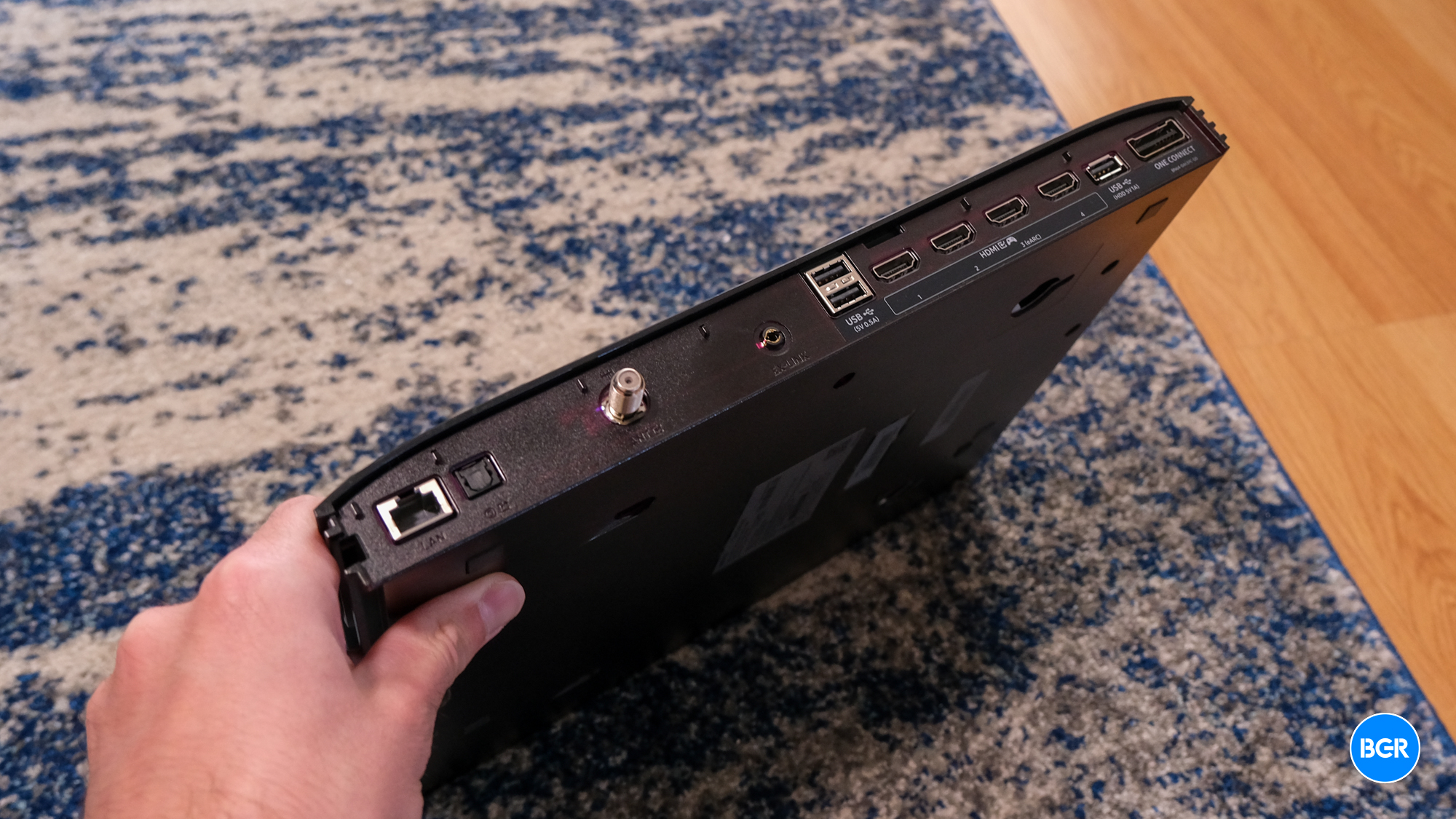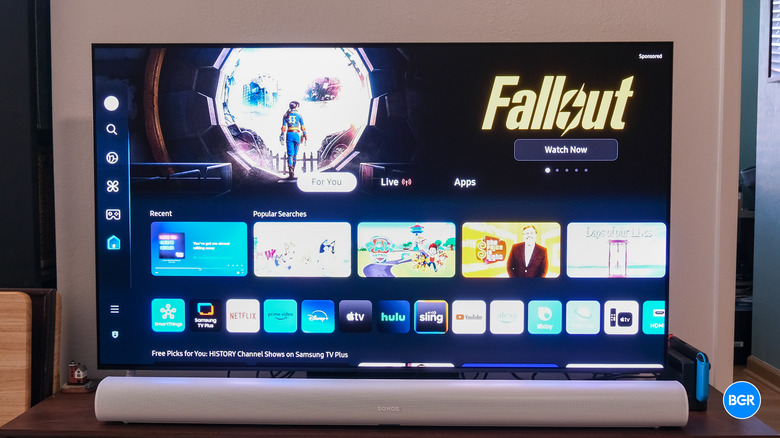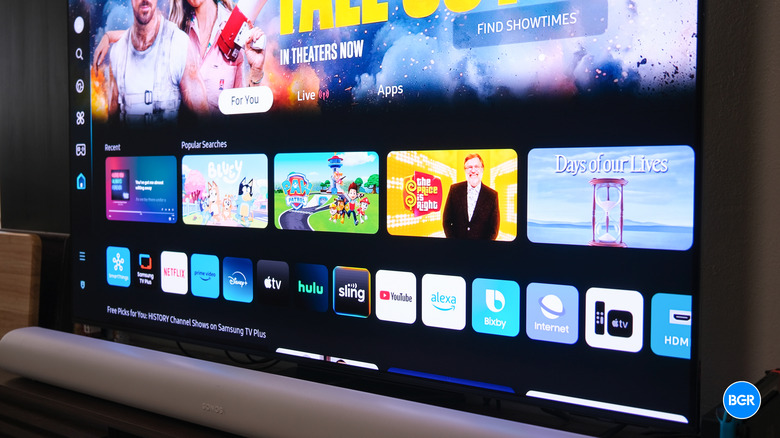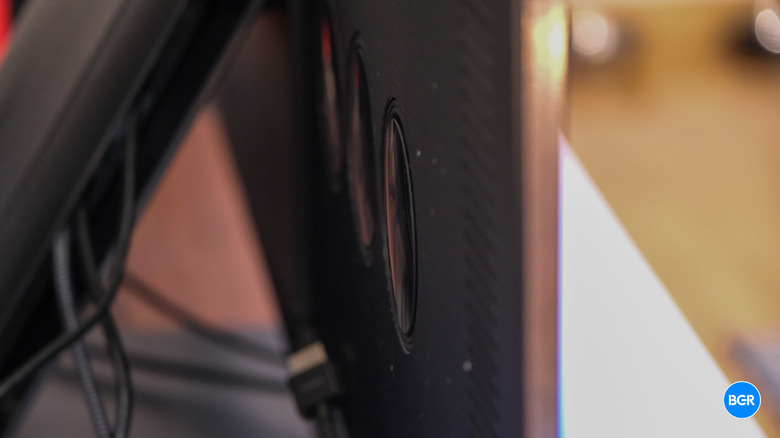Samsung S95D Review: Best TV Picture Quality In 2024
- Incredible true blacks
- Vibrant, bright colors
- Stunningly thin design
- Helpful software
- Glare reduction tech works well
- No Dolby Vision
| Buy From | List Price | Sale Price | |
|---|---|---|---|
| Amazon | $2,597.99 | $2,397.99 | See It |
We may receive a commission on purchases made from links.
Samsung is taking aim at LG. LG has long been the king of OLED, which, to date, has meant that LG TVs often offered better black levels but lower brightness, while Samsung TVs offered higher brightness but weren't as good at controlling black levels. But with its QD-OLED TVs, Samsung aims to bring the best of OLED and quantum dots together. The Samsung S95D is the second generation QD-OLED TV, and it clearly has a lot to offer.
Of course, as an ultra-high-end TV, the Samsung S95D doesn't come cheap. The 55-inch model I reviewed costs an eye-watering $2,600. Can the TV do enough to justify its price? And does this newer technology prove itself? I used the Samsung S95D for a while to find out.
Samsung S95D specs
| Display size | 55, 65, 77 inches |
| Resolution | 4K |
| Display type | QD-OLED |
| Refresh rate | 144Hz |
| Ports | 1 x HDMI eARC, 3 x HDMI 2.1, 3 x USB-A, 1 x USB-C, Optical |
| HDR support | HLG, HDR10+ |
| Software | Samsung Tizen |
| Price | $2,599.99 – $4,599.99 |
Design
The Samsung S95D is an expensive TV, and it looks like one. It's absolutely stunning. The TV boasts one of the sleekest and most stylish designs out there, with a floating screen that uses a large foot to connect to the back of the ultra-thin display.
The 55-inch model I reviewed is only 0.4 inches thick, and it makes for a very premium-looking screen overall. It's able to get so thin by stuffing most of the brains and connectivity into the so-called OneConnect Box, which is a neat idea. The box sits on the foot and connects with a single cable to the display itself.
Because the TV is so thin, it feels very fragile — so you'll want to be careful when you set it up. It's a good idea to set it up with at least one other person, even when setting up the smaller 55-inch model.

The OneConnect Box has a solid selection of ports, too. The box offers four HDMI 2.1 ports, one of which is the HDMI eARC port. Additionally, it has three USB-A ports, and one USB-C port, which can be used for data. There's also an optical port. It's a great selection of connectivity options, and I'm glad to see TVs offer only HDMI 2.1 ports.
Software and features
As you would expect, the TV comes with Samsung's Tizen operating system, which works quite well. The operating system hasn't changed all that much over the past few years, but that's not necessarily a bad thing — it's relatively easy to navigate and supports a range of smart features. Of course it also supports all the streaming services you would expect.
Samsung has also been building out content-specific features over the past few years. The standout example is the Samsung Gaming Hub, which supports services like Xbox Cloud Streaming but also pulls together connections from your gaming consoles that you can jump into as needed. The TV also makes it relatively easy to tweak all your preferred settings and features.
Performance
Of course, the headline feature of the Samsung S95D is the fact that it has Samsung's QD-OLED display. The concept is pretty simple. Traditional OLED TVs really only use OLED technology as the backlight — then shine that light through color filters like a traditional LED display. Quantum dot TVs traditionally use LED backlights and shine that light through quantum dots, which block less light than typical color filters and make for more vibrant colors. QD-OLED TVs offer the best of both worlds. They use an OLED panel with pixel-by-pixel control for true black levels and a layer of quantum dots for a brighter image with more vibrant colors.
Indeed, the image quality on the Samsung S95D is absolutely stunning. Black levels are deep and natural, and the image was able to get bright enough to make for a huge amount of contrast. Colors were vibrant and deep. Really, this is the best TV I've ever looked at. It's easy to see why Samsung charges for the privilege, though I do hope that QD-OLED tech gets cheaper over time. There's no reason to expect that it won't.
The TV goes further than the under-the-hood tech though. It also has Samsung's OLEd Glare Free tech, which I found to work very well. The goal of this tech is to better prevent glare by diffusing light in a way that makes it less distracting.
The big difference between the S95D and the S95C is the fact that the S95D is brighter. I didn't conduct a full review of the S95C, but I have certainly seen it in person, and already found it to offer a solid level of brightness. The S95D definitely brings brightness to the next level, though. The TV also has excellent upscaling, especially from 1080p content.
The TV is also great at off-angle viewing. I happened to be testing this TV while my family was visiting from overseas, so there were plenty of occasions to view the image without being directly in front of the screen. Even at higher angles, you should expect to get a great image with the Samsung S95D.
The S95D isn't perfect, though. Samsung still refuses to license Dolby Vision technology, and while it does excel at producing HDR10+ content, I would have liked to finally see Dolby Vision, especially on a TV in this price range.
Audio
To be clear, those who buy the S95D will do so for the image quality, not the audio quality — and if you do end up buying the TV, you should pair it with a solid sound system. However, in a pinch, you may have to rely on the speakers built into the TV.
I found that it offered a better audio quality than I expected, but still not up to the standards of a solid soundbar or speaker system. The bass in particular was lacking, however I did find that the mids were relatively well-tuned (if not a little boosted), while there was great detail and clarity in the high-end. The speakers get very loud, too.
Again, you should pair this TV with a decent soundbar — but the speakers built into it do sound a little better than I expected, which is certainly nice.
Conclusions
The Samsung S95D is the best-looking TV out there right now. It delivers incredible true blacks with bright highlights and vibrant colors. It's very well-designed too, and offers a good selection of ports. Audio quality is expectedly only fine — however the main downside to the TV for me, apart from the price, is the lack of Dolby Vision support.
The competition
Samsung has built this TV to compete with the other best TVs in the business, including the likes of the LG G4, which is probably its biggest competition right now. They're both incredible-looking TVs, and LG has been working on making its TVs brighter as well. However, side-by-side, the Samsung S95D offers a slightly brighter image. However, you really can't go wrong with either of these two TVs.
Should I buy the Samsung S95D?
Yes, if you're looking for the best TV right now and are willing to pay for it.



